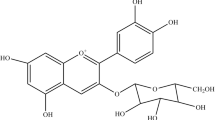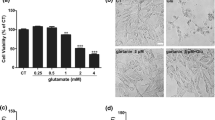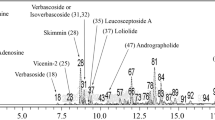Abstract
Epigallocatechin-3-gallate (EGCG), a catechin polyphenols component, is the main ingredient of green tea extract. It has been reported that EGCG is a potent antioxidant and beneficial in oxidative stress-related diseases, but others and our previous study showed that EGCG has pro-oxidant effects at high concentration. Thus, in this study, we tried to examine the possible pathway of EGCG-induced cell death in cultures of rat hippocampal neurons. Our results showed that EGCG caused a rapid elevation of intracellular free calcium levels ([Ca2+]i) in a dose-dependent way. Exposure to EGCG dose- and time-dependently increased the production of reactive oxygen species (ROS) and reduced mitochondrial membrane potential (Δψ m) as well as the Bcl-2/Bax expression ratio. Importantly, acetoxymethyl ester of 5,5′-dimethyl-bis(o-aminophenoxy)ethane-N,N,N′,N′-tetraacetic acid, ethylene glycol-bis-(2-aminoethyl)-N,N,N′,N′-tetraacetic acid, and vitamin E could attenuate EGCG-induced apoptotic responses, including ROS generation, mitochondrial dysfunction, and finally partially prevented EGCG-induced cell death. Furthermore, treatment of hippocampal neurons with EGCG resulted in an elevation of caspase-3 and caspase-9 activities with no significant accompaniment of lactate dehydrogenase release, which provided further evidence that apoptosis was the dominant mode of EGCG-induced cell death in cultures of hippocampal neurons. Taken together, these findings indicated that EGCG induced hippocampal neuron death through the mitochondrion-dependent pathway.








Similar content being viewed by others
Abbreviations
- Ac-DEVD-pNA:
-
Acetyl-Asp-Glu-Val-Asp p-nitroanilide
- Ac-LEHD-pNA:
-
Acetyl-Leu-Glu-His-Asp p-nitroanilide
- BAPTA-AM:
-
Acetoxymethyl ester of 5,5′-dimethyl-bis(o-aminophenoxy)ethane-N,N,N′,N′-tetraacetic acid
- CNS:
-
Central nervous system
- DCF:
-
Dichlorofluorescein
- DCFH-DA:
-
2′,7′-Dichlorofluorescein diacetate
- DMEM:
-
Dulbecco’s modified Eagle’s medium
- DMSO:
-
Dimethyl sulfoxide
- EGCG:
-
Epigallocatechin-3-gallate
- EGTA:
-
Ethylene glycol-bis-(2-aminoethyl)-N,N,N′,N′-tetraacetic acid
- ER:
-
Endoplasmic reticulum
- Fluo-3-AM:
-
Fluo-3-acetoxymethyl ester
- HEPES:
-
4-(2-hydroxyethyl)-1-201 piperazineethanesulfonic acid
- JC-1:
-
5,5′,6,6′-Tetrachloro-1,1′,3,3′-tetraethylbenzimidazolcarbocyanine iodide
- LDH:
-
Lactate dehydrogenase
- mPT:
-
Mitochondria permeability transition
- MTT:
-
3-(4,5-Dimethylthiazol-2-yl)-2,5-diphenyltetrazolium bromide
- PBS:
-
Phosphate-buffered saline
- PI:
-
Propidium iodide
- pNA:
-
p-nitroanilide
- ROS:
-
Reactive oxygen species
- Δψ m :
-
Mitochondrial membrane potential
References
Akhtar RS, Ness JM, Roth KA (2004) Bcl-2 family regulation of neuronal development and neurodegeneration. Biochim Biophys Acta 1644:189–203
Babich H, Zuckerbraun HL, Wurzburger BJ, Rubin YL, Borenfreund E, Blau L (1996) Benzoyl peroxide cytotoxicity evaluated in vitro with the human keratinocyte cell line, RHEK-1. Toxicology 106:187–196
Bandele OJ, Osheroff N (2008) (−)-Epigallocatechin gallate, a major constituent of green tea, poisons human type II topoisomerases. Chem Res Toxicol 21:936–943
Berridge MJ, Lipp P, Bootman MD (2000) The versatility and universality of calcium signalling. Nat Rev Mol Cell Biol 1:11–21
Cafe C, Torri C, Bertorelli L, Tartara F, Tancioni F, Gaetani P, Rodriguez y, Baena R, Marzatico F (1995) Oxidative events in neuronal and glial cell-enriched fractions of rat cerebral cortex. Free Radic Biol Med 19:853–857
Carriedo SG, Sensi SL, Yin HZ, Weiss JH (2000) AMPA exposures induce mitochondrial Ca2+ overload and ROS generation in spinal motor neurons in vitro. J Neurosci 20:240–250
Chacon E, Acosta D (1991) Mitochondrial regulation of superoxide by Ca2+: an alternate mechanism for the cardiotoxicity of doxorubicin. Toxicol Appl Pharmacol 107:117–128
Choi D, Kim D, Park Y, Chun B, Choi S (2002) Protective effects of rilmenidine and AGN 192403 on oxidative cytotoxicity and mitochondrial inhibitor-induced cytotoxicity in astrocytes. Free Radic Biol Med 33:1321–1333
Chow H-HS, Cai Y, Alberts DS, Hakim I, Dorr R, Shahi F, Crowell JA, Yang CS, Hara Y (2001) Phase I pharmacokinetic study of tea polyphenols following single-dose administration of epigallocatechin gallate and polyphenon E. Cancer Epidemiol Biomarkers Prev 10:53–58
Chung F-L, Schwartz J, Herzog CR, Yang Y-M (2003) Tea and cancer prevention: studies in animals and humans. J Nutr 133:3268S–3274S
Doutheil J, Althausen S, Gissel C, Paschen W (1999) Activation of MYD116(gadd34) expression following transient forebrain ischemia of rat: implications for a role of disturbances of endoplasmic reticulum calcium homeostasis. Brain Res Mol Brain Res 63:225–232
Dugan L, Sensi S, Canzoniero L, Handran S, Rothman S, Lin T, Goldberg M, Choi D (1995) Mitochondrial production of reactive oxygen species in cortical neurons following exposure to N-methyl-d-aspartate. J Neurosci 15:6377–6388
Ermak G, Davies KJ (2002) Calcium and oxidative stress: from cell signaling to cell death. Mol Immunol 38:713–721
Fleury C, Mignotte B, Vayssière J-L (2002) Mitochondrial reactive oxygen species in cell death signaling. Biochimie 84:131–141
Guo Q, Sopher BL, Furukawa K, Pham DG, Robinson N, Martin GM, Mattson MP (1997) Alzheimer's presenilin mutation sensitizes neural cells to apoptosis induced by trophic factor withdrawal and amyloid-peptide: involvement of calcium and oxyradicals. J Neurosci 17:4212–4222
Hwang J-T, Ha J, Park I-J, Lee S-K, Baik HW, Kim YM, Park OJ (2007) Apoptotic effect of EGCG in HT-29 colon cancer cells via AMPK signal pathway. Cancer Lett 247:115–121
Isbrucker RA, Bausch J, Edwards JA, Wolz E (2006) Safety studies on epigallocatechin gallate (EGCG) preparations. Part 1: Genotoxicity. Food Chem Toxicol 44:626–635
Kanadzu M, Lu Y, Morimoto K (2006) Dual function of (−)-epigallocatechin gallate (EGCG) in healthy human lymphocytes. Cancer Lett 241:250–255
Lambert JD, Yang CS (2003) Mechanisms of cancer prevention by tea constituents. J Nutr 133:3262s–3267s
Lambert JD, Sang S, Yang CS (2007) Possible controversy over dietary polyphenols: benefits vs risks. Chem Res Toxicol 20:583–585
Lin HH, Li W-W, Lee Y-C, Chu S-T (2007) Apoptosis induced by uterine 24p3 protein in endometrial carcinoma cell line. Toxicology 234:203–215
Makar TK, Nedergaard M, Preuss A, Gelbard AS, Perumal AS, Cooper AJL (1994) Cooper, vitamin E, ascorbate, glutathione, glutathione disulfide and enzymes of glutathione metabolism in cultures of chick astrocytes and neurons: evidence that astrocytes play an important role in antioxidative process in the brain. J Neurochem 62:45–53
Marttila RJ, Roytta M, Lorentz H, Rinne UK (1988) Oxygen toxicity protecting enzymes in the human brain. J Neural Transm 74:87–95
Mattson MP, Lovell MA, Furukawa K, Markesbery WR (1995) Neurotrophic factors attenuate glutamate-induced accumulation of peroxides, elevation of [Ca2+]i and neurotoxicity, and increase antioxidant enzyme activities in hippocampal neurons. J Neurochem 65:1740–1751
Nakagawa T, Yokozawa T (2002) Direct scavenging of nitric oxide and superoxide by green tea. Food Chem Toxicol 40:1745–1750
Nicotera P, Zhivotovsky B, Orrenius S (1994) Nuclear calcium transport and the role of calcium in apoptosis. Cell Calcium 16:279–288
Norenberg MD, Rao KVR (2007) The mitochondrial permeability transition in neurologic disease. Neurochem Int 50:983–997
Park HJ, Shin D-H, Chung WJ, Leem K, Yoon SH, Hong MS, Chung J-H, Bae J-H, Hwang JS (2006) Epigallocatechin gallate reduces hypoxia-induced apoptosis in human hepatoma cells. Life Sci 78:2826–2832
Raza H, John A (2005) Green tea polyphenol epigallocatechin-3-gallate differentially modulates oxidative stress in PC12 cell compartments. Toxicol Appl Pharmacol 207:212–220
Reyes-Martin P, Alique M, Parra T, JPd Hornedo, Lucio-Cazana J (2007) Cyclooxygenase-independent inhibition of H2O2-induced cell death by S-ketoprofen in renal cells. Pharmacol Res 55:295–302
Saffari Y, Sadrzadeh SMH (2004) Green tea metabolite EGCG protects membranes against oxidative damage in vitro. Life Sci 74:1513–1518
Sai K, Kai S, Umemura T, Tanimura A, Hasegawa R, Inoue T, Kurokawa Y (1998) Protective effects of green tea on hepatotoxicity, oxidative DNA damage and cell proliferation in the rat liver induced by repeated oral administration of 2-nitropropane. Food Chem Toxicol 36:1043–1051
Sakagami H, Arakawa H, Maeda M, Satoh K, Kadofuku T, Fukuchi K, Gomi K (2001) Production of hydrogen peroxide and methionine sulfoxide by epigallocatechin gallate and antioxidants. Anticancer Res 21:2633–2641
Schmidt M, Schmitz HJ, Baumgart A, Guedon D, Netsch MI, Kreuter MH, Schmidlin CB, Schrenk D (2005) Toxicity of green tea extracts and their constituents in rat hepatocytes in primary culture. Food Chem Toxicol 43:307–314
Sugisawa A, Umegaki K (2002) Physiological concentrations of (−)-epigallocatechin-3-O-gallate (EGCg) prevent chromosomal damage induced by reactive oxygen species in WIL2-NS cells. J Nutr 132:1836–1839
Sunanda, Rao BS, Raju TR (1998) Corticosterone attenuates zinc-induced neurotoxicity in primary hippocampal cultures. Brain Res 791:295–298
Yang CS, Chen L, Lee M-J, Balentine D, Kuo MC, Schantz SP (1998) Blood and urine levels of tea catechins after ingestion of different amounts of green tea by human volunteers. Cancer Epidemiol Biomarkers Prev 7:351–354
Yao K, Ye P, Zhang L, Tan J, Tang X, Zhang Y (2008) Epigallocatechin gallate protects against oxidative stress-induced mitochondria-dependent apoptosis in human lens epithelial cells. Mol Vis 14:217–223
Yin ST, Tang ML, Su L, Chen L, Hu P, Wang HL, Wang M, Ruan DY (2008) Effects of epigallocatechin-3-gallate on lead-induced oxidative damage. Toxicology 249:45–54
Yokoyama Y, Nohara K, Okubo T, Kano I, Akagawa K, Kano K (2007) Generation of reactive oxygen species is an early event in dolichyl phosphate-induced apoptosis. J Cell Biochem 100:349–361
Zhang H, Brunk UT (1993) Alloxan cytotoxicity is highly potentiated by plasma membrane- and lysosomal-associated iron—a study on a model system of cultured J-774 cells. Diabetologia 36:707–715
Acknowledgments
This work was supported by the National Nature Science Foundation of China (Nos. 30630057, 30670554, and 30670662) and Anhui High Education Natural Science Program (No. ZD2008010-2).
Author information
Authors and Affiliations
Corresponding author
Rights and permissions
About this article
Cite this article
Yin, ST., Tang, ML., Deng, HM. et al. Epigallocatechin-3-gallate induced primary cultures of rat hippocampal neurons death linked to calcium overload and oxidative stress. Naunyn-Schmied Arch Pharmacol 379, 551–564 (2009). https://doi.org/10.1007/s00210-009-0401-4
Received:
Accepted:
Published:
Issue Date:
DOI: https://doi.org/10.1007/s00210-009-0401-4




